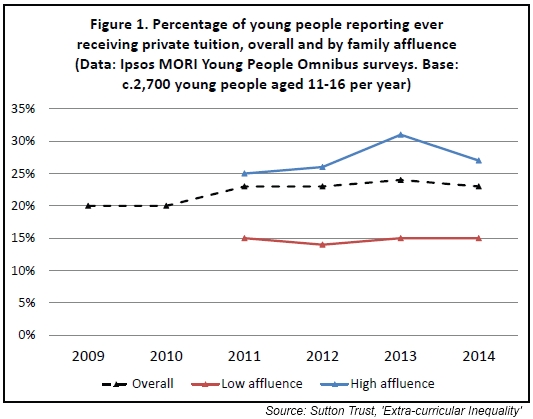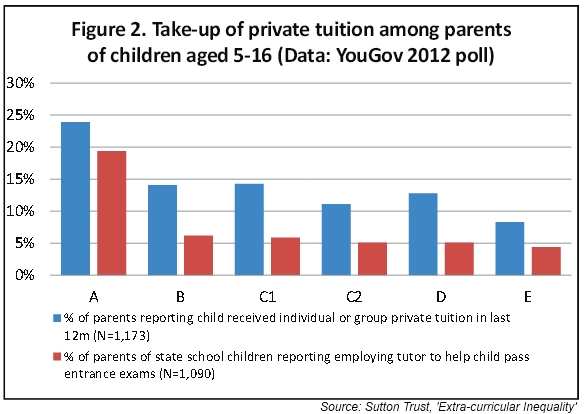Earlier this year, I blogged about some of the latest trends in private tuition from the tutor’s (supply-side) perspective. Now, thanks to a new research report by the Sutton Trust, we now have a clearer picture than ever before of the demand-side; that is, the children in the UK who are taking private tuition and the parents who are paying for it.
Key findings – pupil survey
The Sutton Trust’s annual Ipsos MORI poll of children in England and Wales has shown that the numbers who reported having received home or private tuition increased from 20% to 23% between 2009 and 2014. Moreover, as the following graph illustrates, there is a significant gap between the percentage of low affluence and high affluence families affording tuition.

Key findings – parental survey
In a separate survey from 2012, the Sutton Trust were also able to obtain data on the social backgrounds of parents who employ private tutors. As the chart below illustrates, parents in social group A (higher managers, administrators or professionals) were 70% more likely to employ tutors than those in social groups B and C1 (intermediate managers etc/ supervisors, clerical workers, administrators etc), and around two to three times more likely to do so than parents in social groups C2, D and E (skilled manual workers / semi and unskilled manual workers / casual or lowest grade workers, the unemployed or state pensioners).

This survey also revealed that:-
- among parents whose children attend state selective schools, those in social group A were three or four times more likely than any other group to have used private tuition to help their child pass the school entrance exams.
- children attending private schools are substantially more likely than those attending state schools to receive private tuition (27% vs 14%).
It is the above two findings which are the most stark. They illustrate that parents in the top social group are using their significant financial clout to ensure the best educational outcomes for their children. They do this firstly by investing heavily in tutoring to facilitate their children’s entry into state selective schools. Secondly, many of these parents will not only send their children to private schools, but will pay for additional private tuition as well, perhaps in a bid to help their children gain an even greater competitive edge over their peers.
Conclusions
The Sutton Trust – which campaigns to improve social mobility through education – is clearly troubled by these findings, and has recommended the introduction of a means tested voucher system as part of the state school ‘pupil premium’ through which lower income families could purchase additional educational support.

Who is taking private tuition? Best data so far. | The Tutor Blog http://t.co/ZqX9SAOTMi via @thetutorpages
@suttontrust Summary of Sutton Trust Extra-Curricular Inequalities report at http://t.co/uHrnYY1i2R